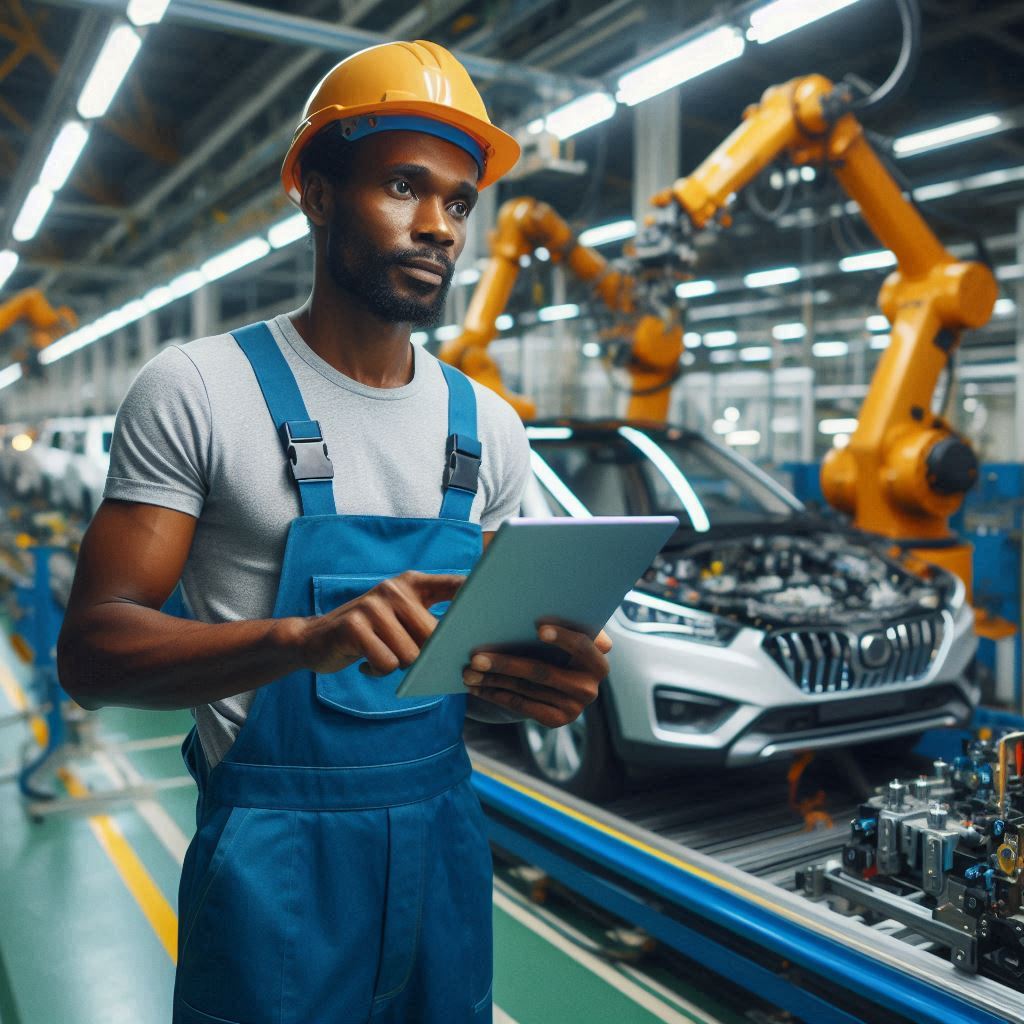Introduction
Brief overview of the current state of manufacturing in Africa
Africa’s manufacturing sector faces several challenges.
These include outdated technology, limited infrastructure, and a scarcity of skilled labor.
However, recent investments and government initiatives aim to improve this landscape.
Innovative solutions and emerging technologies are gaining traction.
Countries like Kenya, Nigeria, and South Africa are spearheading these changes.
Robotics and its significance in modern industries
Robotics brings transformative power to industries across the globe.
These machines enhance productivity, reduce labor costs, and increase efficiency.
In modern manufacturing, robots perform repetitive tasks, allowing human workers to focus on complex issues.
Their precision improves product quality while minimizing waste.
Consequently, many industries are now rapidly integrating robotics into their processes.
Purpose of the blog: to explore how robotics is transforming manufacturing in Africa
This blog explores robotics’ pivotal role in Africa’s manufacturing revolution.
As the continent looks to modernize, robots can bridge existing gaps.
They offer solutions for improving production capabilities and enhancing workplace safety.
Moreover, robotics fosters innovation in sectors like textiles, automotive, and electronics.
By streamlining operations, African manufacturers gain a competitive edge in the global market.
Innovative Tech Solutions, Tailored for You
Our leading tech firm crafts custom software, web & mobile apps, designed with your unique needs in mind. Elevate your business with cutting-edge solutions no one else can offer.
Start NowTherefore, robotics has become a game-changer in African manufacturing.
Countries across the continent are beginning to harness this technology.
The shift towards automation represents a significant opportunity for growth.
As robotics continues to evolve, Africa can look forward to a more efficient manufacturing landscape.
The Evolution of Robotics in Manufacturing
Historical Context of Robotics in Global Manufacturing
The journey of robotics in manufacturing began in the early 20th century.
Factories used mechanical devices for repetitive tasks.
These machines enhanced efficiency and reduced human labor costs.
The introduction of the first industrial robots occurred in the 1950s.
George Devol and Joseph Engelberger pioneered this technology.
Their invention, Unimate, revolutionized assembly lines.
This robot performed tedious tasks, lifting heavy materials.
Throughout the 1970s and 1980s, the robotics industry expanded rapidly.
Various sectors, including automotive and electronics, sought automation.
Japan led the way in adopting industrial robots.
Companies like Fanuc and Kawasaki developed advanced robotic systems.
These robots improved precision and speed on production lines.
As the new millennium approached, affordability and accessibility became key.
Manufacturers sought ways to remain competitive in a global market.
The introduction of collaborative robots emerged in the 2000s.
These cobots work alongside humans safely and efficiently.
This innovation further propelled robotics into mainstream manufacturing.
Today, robotics technology plays a critical role globally.
It continues evolving and adapting to industry needs.
Smart factories leverage the Internet of Things (IoT) for enhanced production.
Seamless API Connectivity for Next-Level Integration
Unlock limitless possibilities by connecting your systems with a custom API built to perform flawlessly. Stand apart with our solutions that others simply can’t offer.
Get StartedRobots integrate seamlessly into complex supply chains.
As a result, productivity and flexibility reach unprecedented levels.
Adoption of Robotics in African Manufacturing Settings
In Africa, the adoption of robotics in manufacturing remains in its infancy.
Various factors influence this gradual uptake.
Economic challenges often hinder investment in robotic systems.
However, growing interest in automation is evident across the continent.
Several African countries are recognizing the potential of robotics.
Nations like South Africa, Kenya, and Nigeria lead the charge.
They have established initiatives aimed at enhancing manufacturing capabilities.
Government policies increasingly support technology adoption.
- South Africa: It boasts a more developed industrial base. South African manufacturers have begun investing in robot technology. The automotive industry particularly benefits from this trend.
- Kenya: The country is actively developing its manufacturing sector. Local startups are exploring robotics and automation solutions.
- Nigeria: Nigeria is focusing on enhancing its manufacturing industry. Robotics could help address skill shortages and improve productivity.
Despite challenges, several sectors embrace robotics.
Food processing, textiles, and pharmaceuticals show significant promise.
These industries aim to streamline operations and reduce costs.
Moreover, African manufacturers are increasingly collaborating with tech firms.
Partnerships facilitate the transfer of knowledge and technology.
This collaboration fosters a deeper understanding of robotics systems.
It also helps local companies customize solutions for their needs.
Key Technological Advancements Driving Robotics Adoption
Several technological advancements are paving the way for robotics in Africa.
Innovations in artificial intelligence (AI) are breaking new ground.
AI enables robots to perform complex tasks independently.
This technology enhances their adaptability and efficiency.
Machine learning is another critical advancement.
It allows robots to improve their performance over time.
Manufacturers can collect data and analyze it for process optimization.
Transform Business with Custom CRM & ERP Solutions
Elevate your operations with a CRM or ERP tailored for you. Let’s build the perfect solution that others can't replicate—crafted to match your business's needs like no other.
Get StartedThis capability significantly reduces downtime and waste.
Furthermore, sensors and connectivity technologies contribute substantially.
Advanced sensors enhance robotic perception.
They allow robots to navigate dynamic environments.
As a result, robots can work alongside humans without safety concerns.
- Internet of Things (IoT): IoT enables machines to communicate and interact. This connectivity allows for real-time monitoring and data analysis. Consequently, it optimizes production processes.
- Cloud Computing: Cloud technology provides access to vast computational resources. Manufacturers can store and analyze data without owning expensive hardware. This flexibility lowers the barriers to entry for robotics.
- Affordable Robotics: Decreasing costs of robotic systems make them accessible. Manufacturers can now invest in automation without overspending. This affordability accelerates the adoption of robots in African manufacturing.
The rapid advancements in robotics are transforming manufacturing globally.
As Africa embraces these technologies, industrial landscapes will shift dramatically.
Manufacturers must remain agile, adapting to new technology trends.
In fact, the evolution of robotics in manufacturing holds tremendous promise.
Africa stands on the cusp of a manufacturing revolution.
As the continent embraces automation, it unlocks potential for economic growth and development.
Through collaboration, innovation, and investment, African countries can harness the power of robotics.
Read: African Digital Payment Systems: Revolutionizing Financial Inclusion
Current Applications of Robotics in African Manufacturing
Automation of Production Lines
Automation through robotics has become a game-changer in African manufacturing.
Manufacturers increasingly adopt robotic arms for various tasks.
These tasks include assembly, welding, and material handling.
By implementing robotic systems, companies can streamline their production processes.
Robots enhance speed and reduce human error significantly.
This results in higher efficiency and lower production costs.
Several industries benefit from this automation trend:
- Automotive Sector: Robots perform assembly and painting tasks efficiently.
- Textile Industry: Robotics automate cutting, sewing, and finishing processes.
- Food Processing: Robots handle packaging, sorting, and palletizing.
Consequently, companies that invest in these technologies experience increased output rates.
They also enjoy improved worker safety by taking on hazardous tasks.
Robotics in Quality Control and Inspection
Quality control remains a critical aspect of manufacturing.
Robotics plays a pivotal role in enhancing quality assurance processes.
Tailored Tech Solutions to Drive Your Business Forward
Maximize your business potential with custom tech strategies. We deliver bespoke solutions that others can’t match, designed to solve your specific challenges with precision and impact.
Contact UsAutomated inspection systems ensure products meet stringent quality standards.
These robotic systems utilize advanced sensors and imaging technology.
They detect defects, measure tolerances, and assess product specifications.
Moreover, they perform these tasks faster than human inspectors.
The application of robotics in quality control offers numerous benefits:
- Increased Accuracy: Robots minimize errors in measurement and inspection.
- Consistent Quality: Automation ensures that quality remains consistent over time.
- Data Collection: Robots gather data easily, providing insights for continuous improvement.
As a result, manufacturers can identify and rectify defects as they occur.
This proactive approach prevents defective products from reaching consumers.
Warehousing and Logistics Automation
As manufacturing operations expand, so do warehousing and logistics needs.
Robotics significantly streamline these areas to enhance efficiency.
Automated systems manage inventory, track shipments, and optimize warehouse layouts.
Robotic systems in warehouses perform the following functions:
- Automated Guided Vehicles (AGVs): These vehicles transport goods without human intervention.
- Robotic Pick-and-Place Systems: They select and package items accurately and swiftly.
- Inventory Management Robots: These keep track of stock levels and locations.
These applications reduce human labor costs and improve speed.
They also minimize the risk of errors in stock handling.
Thus, manufacturers can respond quickly to changing market demands.
Case Studies of Successful Implementations in African Companies
Numerous African companies have successfully integrated robotics into their manufacturing processes.
These success stories showcase the potential of robotics in transforming the industry.
One notable example is a South African automotive manufacturer.
They implemented robotic arms along their assembly line.
This move increased production capacity by 30% within six months.
The quality of their vehicles improved significantly as well.
Another example involves a Kenyan textile firm.
By automating sewing processes, they reduced labor costs by 20%.
Additionally, they improved production speed and accuracy.
In Nigeria, a food processing company adopted robotic packaging systems.
This change led to a 25% reduction in operational costs.
Their throughput increased while maintaining product quality standards.
These case studies illustrate the variety of industries benefiting from robotics.
They highlight the tangible improvements in productivity and quality.
Challenges and Future Prospects
Despite the advancements, several challenges remain.
Initial investment costs for robotics can be high.
Furthermore, a skills gap exists among the workforce.
Training programs must be developed to address the skills shortage.
Education must focus on equipping workers with necessary technological skills.
This approach ensures that they can operate and maintain automated systems effectively.
Looking ahead, the future of robotics in African manufacturing appears promising.
The adoption of Industry 4.0 principles will further enhance operations.
Manufacturers will increasingly rely on data analytics, IoT, and AI alongside robotics.
As the cost of robotics technology decreases, more companies will invest in automation.
With these advancements, African manufacturing will likely become more competitive globally.
Read: The Role of Tech Incubators in Nurturing Africa’s Next Unicorns
Benefits of Robotics in African Manufacturing
Increased Efficiency and Productivity
Robotics transforms manufacturing processes across Africa.
These advanced machines significantly boost operational efficiency.
Businesses experience shorter production cycles as robotic systems operate at high speeds.
Unlike human workers, robots do not tire; thus they maintain consistent output.
For example, automating assembly lines drastically reduces time spent on repetitive tasks.
With robots, manufacturers can run operations 24/7.
This uninterrupted work schedule leads to maximized output.
Companies can respond faster to market demands and increase production volumes when necessary.
The ability to reprogram robots for various tasks also enhances flexibility in manufacturing.
Businesses can adapt their production lines to meet changing consumer needs promptly.
A report from the African Development Bank illustrates that firms incorporating robotics see increases in productivity by up to 30%.
Such gains are essential for Africa’s competitive edge when exporting goods.
Enhanced productivity enables manufacturers to lower lead times, thus improving customer satisfaction.
Overall, robots drive efficiency to levels previously unseen in the continent’s factories.
Cost Reduction in Long-Term Operations
Initial investments in robotics may appear hefty. However, the long-term savings they bring are considerable.
Robots help minimize labor costs by reducing the number of workers needed for specific tasks.
Although operational expenses might rise with higher power consumption, the overall costs decrease over time.
Maintenance of robotic systems is often less expensive than managing human labor.
Robots require routine upkeep, which is generally predictable.
Unlike human workers, robots do not require salaries, benefits, or healthcare.
This translates to significant financial relief for manufacturing firms in Africa.
Additionally, robots excel in performing tasks that traditionally incur high error rates.
Their precision reduces waste and rework costs. Over time, lower defect rates lead to further savings.
A McKinsey report indicates that spending on robotics can break even within a few years due to these cumulative savings.
Enhanced Product Quality and Consistency
Consistency in production quality is vital for the success of any manufacturing operation.
Robots excel in executing tasks with high precision, significantly reducing variability.
This precision translates directly into superior product quality.
Each unit produced meets the required specifications, enhancing brand reputation.
Automated systems can inspect products throughout the manufacturing process.
Quality control measures become more rigorous and efficient with robotic systems.
For instance, sensors integrated into robotic machines identify defects in real-time.
This capability allows manufacturers to address issues before products reach consumers, thus preventing costly recalls.
Moreover, businesses can leverage data and analytics provided by robots.
Advanced software systems analyze production data to identify areas for improvement.
These insights help manufacturers refine processes and maintain high standards.
As a result, businesses can produce high-quality goods consistently, retaining consumer trust and loyalty.
Improved Worker Safety and Ergonomics
Safety has always been a primary concern in manufacturing environments.
Robotics play a significant role in enhancing worker safety on production floors.
By assigning hazardous tasks to robots, companies can protect employees from injury.
For example, handling heavy machinery or dangerous materials becomes the responsibility of robotic systems.
Furthermore, the ergonomics of workspaces improve dramatically.
Robots can perform repetitive motions that can cause strain or injury to workers.
Consequently, employees can focus on more strategic and less physically taxing responsibilities.
Improved ergonomic designs and workflows lead to healthier work environments overall.
Statistics show that factories that integrate robotics experience fewer workplace accidents.
A safer working environment fosters employee satisfaction and productivity.
As workers feel safer, they can contribute more effectively and efficiently to production goals.
Moreover, reducing the physical demands of manufacturing can lead to lower employee turnover rates.
Companies invest in their workforce, resulting in improved morale.
With a satisfied workforce, businesses can maintain a consistent level of output without the disruptions that come from high turnover.
Robotics is undeniably revolutionizing manufacturing across Africa.
The benefits derived from increased efficiency, cost savings, enhanced product quality, and improved worker safety create a compelling case for adoption.
As more manufacturers recognize these advantages, the landscape of African manufacturing will continue to evolve.
Embracing robotics is not just a trend; it is essential for sustainable growth and competitiveness in a global market.
Companies that invest in robotics today will lead the way for others tomorrow, establishing Africa as a powerhouse in manufacturing.
Read: African Renewable Energy Startups: Driving the Green Tech Movement

Challenges Faced in Implementing Robotics
The integration of robotics into Africa’s manufacturing landscape presents a range of challenges.
These obstacles can hinder progress and affect the overall efficiency of operations.
Understanding these challenges is crucial for realizing the full potential of robotics in the continent’s industries.
Here, we explore some major hurdles that companies face.
High Initial Investment Costs
One significant barrier to implementing robotics in manufacturing is the high initial investment required.
Businesses often find themselves questioning the cost-effectiveness of these technologies.
Key factors contributing to these costs include:
- Purchase price of robotic systems: Advanced robots are expensive, deterring initial investment.
- Integration with existing systems: Companies might incur extra costs when integrating robots into current processes.
- Maintenance and support: Ongoing maintenance expenses can significantly add to the total cost of ownership.
- Training for employees: Companies must often allocate funds for acquiring specialized training for their workforce.
- Infrastructure upgrades: In some cases, manufacturers need to invest in enhancing their facilities to accommodate robots.
These factors often overwhelm small and medium-sized enterprises (SMEs), limiting their ability to adopt robotic technologies.
Without substantial upfront capital, many companies struggle to transition into automated production.
Lack of Skilled Workforce and Training Programs
A skilled workforce is vital for the successful implementation of robotics.
Unfortunately, many African nations face a glaring shortage of skilled workers trained in robotics and automation technologies.
This skill gap presents several challenges:
- Insufficient technical education: Many educational institutions in Africa do not offer programs focusing on robotics and automation.
- Limited on-the-job training: Few companies provide hands-on training programs to develop robotic competencies among their employees.
- Brain drain: Talented professionals often migrate to developed countries for better opportunities, exacerbating the skill shortage.
- Inadequate resources for training: Organizations frequently lack the funding and infrastructure required to establish proper training facilities.
- Resistance to upskilling: Some employees resist learning new technologies, limiting the adoption of robotics.
This lack of skilled personnel hampers companies’ ability to harness the full potential of robotics.
Manufacturers might find themselves unable to operate sophisticated robotic systems efficiently.
Infrastructure and Technological Limitations
Africa’s infrastructure issues also pose significant challenges for implementing robotics in manufacturing.
Several aspects contribute to these limitations:
- Poor energy supply: Unreliable electricity can disrupt the operation of robotic systems, leading to production delays.
- Inadequate internet connectivity: Many regions lack the necessary internet services to support cloud-based robotic solutions.
- Transport and logistics challenges: Poor infrastructure can complicate the transportation of goods and raw materials.
- Limited access to advanced technologies: Manufacturers often struggle to acquire the latest robotics technologies due to financial constraints.
- Regulatory hurdles: Bureaucratic obstacles may inhibit companies from adopting advanced technologies quickly.
These technological limitations can undermine investment in robotics.
Without robust infrastructure, companies cannot ensure the continuous and reliable operation of these systems.
Resistance to Change within Traditional Manufacturing Sectors
Change is often met with skepticism, especially in established manufacturing sectors.
Resistance to adopting robotics can stem from various factors:
- Fear of job loss: Employees worry that automation will lead to job displacement and unemployment.
- Comfort with traditional methods: Many manufacturers prefer familiar, traditional production methods over robotic systems.
- Concerns about reliability: Some manufacturers doubt the reliability of robots, worried they may malfunction or require constant upkeep.
- Lack of awareness: There is often insufficient understanding of the benefits of robotics and automation.
- Complexity of transitioning: Companies may view the transition to automated systems as too complex and daunting.
This resistance can create a significant barrier to robotics adoption.
Overcoming these attitudes requires effective change management strategies and clear communication about the benefits of automation.
In essence, while robotics holds immense potential for transforming manufacturing in Africa, several challenges must be addressed.
Companies need to navigate high initial investment costs, the shortage of skilled workers, infrastructural limitations, and resistance to change.
By acknowledging and proactively tackling these hurdles, Africa can move closer to realizing the full benefits of robotics in manufacturing.
Manufacturers that invest in training programs, improve infrastructure, and foster a culture of innovation can successfully implement robotic technologies.
This proactive approach can help overcome the challenges faced, driving progress within Africa’s manufacturing sector.
Read: Blockchain Adoption in African Governments: A New Era of Transparency
The Role of Government and Policy in Promoting Robotics
Government Initiatives Supporting Technological Integration
Governments across Africa recognize the importance of robotics in enhancing manufacturing.
They initiate various programs to facilitate technological integration.
These programs include:
- Funding and Grants: States provide funding for companies investing in robotic technologies. This financial assistance reduces the barriers to entry for small enterprises.
- Tax Incentives: Many governments offer tax breaks for businesses that adopt advanced technologies. These incentives promote the purchase of robotic machinery.
- Research and Development (R&D) Support: Governments encourage R&D through grants or loans. They build innovation hubs to support local researchers and engineers.
- Infrastructure Improvements: State investment in digital and physical infrastructure bolsters manufacturing capabilities. Enhanced internet connectivity facilitates the integration of robotics.
- Standards and Regulations: Developing clear regulations and standards ensures safe robotic deployment. Governments create guidelines to manage technological risk while promoting growth.
In countries like Kenya and South Africa, these initiatives have resulted in significant updates to the manufacturing landscape.
The incorporation of robotics goes hand-in-hand with government policies, shaping a future-ready workforce.
Policies Aimed at Workforce Development and Upskilling
As robotics technology evolves, the need for skilled workers increases significantly.
Governments must prioritize upskilling initiatives.
To achieve this, they implement various policies:
- Vocational Training Programs: State-funded vocational training centers provide hands-on training for the workforce. These programs focus on skills relevant to robotics and automation.
- Partnerships with Industry: Collaboration with businesses ensures curriculum relevance. Educational programs align with industry needs, ensuring graduates are job-ready.
- Scholarships for Technical Education: Governments offer scholarships targeting STEM fields. Such initiatives encourage students to pursue technology-focused careers.
- Continuous Professional Development: Policies supporting lifelong learning are crucial. Workshops and online courses help professionals keep up with evolving technologies.
- Public Awareness Campaigns: Raising awareness about the benefits of robotics attracts young talent. Governments promote STEM careers through campaigns and workshops in schools.
Investing in workforce development ensures a smooth transition toward an automated manufacturing environment.
As a result, this creates job opportunities where technical skills are essential.
Collaborations between Governments, Educational Institutions, and Industry
Successful robotics integration relies on collaborative efforts involving various stakeholders.
These partnerships foster innovation and practical applications of robotic technology.
Governments play a pivotal role in facilitating collaboration between:
- Educational Institutions: Universities and technical colleges provide a skilled workforce. They conduct research to further understanding of robotics.
- Industry Players: Companies share insights about their technological needs. This feedback shapes educational programs and enhances R&D efforts.
- Non-Governmental Organizations (NGOs): NGOs often support community development through technological training. Their involvement enhances outreach and impact.
- International Partnerships: Collaborating with foreign governments and organizations brings best practices. Countries can leverage international expertise and resources for innovation.
- Research Institutions: Partnerships with specialized research bodies foster cutting-edge advancements. These collaborations lead to innovative solutions in robotic applications.
For instance, initiatives like the African Robotics Network (ARN) exemplify how collaboration drives progress.
ARN connects educational institutions and industry leaders, fostering innovation across the continent.
In summary, governments in Africa play a pivotal role in advancing robotics in manufacturing.
Their initiatives address technological integration, workforce training, and collaborative efforts.
Such policies not only enhance manufacturing efficiency but also ensure inclusivity and sustainability.
Africa stands on the brink of a robotics revolution.
With government support, the continent can harness advanced manufacturing technologies.
As these initiatives roll out, the impacts on economic growth and workforce dynamics will become increasingly evident.
For Africa, the future promises to be bright as it embraces robotics.
Future Trends in Robotics and Manufacturing in Africa
The future of robotics in Africa promises significant advancements.
These advancements will transform the manufacturing landscape.
The integration of artificial intelligence (AI) and machine learning stands out as pivotal in this transformation.
Emerging technologies will empower industries to innovate and optimize their processes.
In addition, a surge in startups dedicated to robotics is expected.
These startups will contribute significantly to job creation and economic growth.
This section explores the potential of AI, the rise of robotics startups, and key predictions for the next decade.
The Potential of Artificial Intelligence and Machine Learning in Robotics
Artificial intelligence and machine learning carry immense potential for robotics in Africa.
They can enhance efficiency across various manufacturing sectors.
Here are some ways AI and machine learning will impact robotics:
- Improved Automation: Robotics equipped with AI can automate routine tasks. This automation increases production rates while reducing error margins.
- Enhanced Decision-Making: AI-driven robots can analyze data and make informed decisions. They will adapt to changes in manufacturing processes quickly.
- Predictive Maintenance: Machine learning can predict equipment failures. This capability minimizes downtime and reduces maintenance costs.
- Quality Control: AI can enhance the consistency of product quality. Robots will detect defects during manufacturing and eliminate them instantly.
- Customization: AI can enable mass customization in production. Robots will adapt to produce various product designs simultaneously.
These advancements highlight the synergy between robotics and AI.
They pave the way for smarter, more responsive production systems.
As African manufacturers embrace these technologies, the potential for growth becomes limitless.
Industries will become more competitive and agile through AI integration.
Growth of Startups Focusing on Robotic Technologies
The landscape of robotics in Africa is witnessing a surge in startups.
These companies are changing how industries implement technologies.
Focused on innovation and efficiency, these startups are emerging in various sectors.
Some noteworthy trends include:
- Local Solutions: Startups are developing robotics solutions tailored for local challenges. This focus addresses unique needs within African markets.
- Investment Influx: Investors are increasingly funding robotic startups. This investment fuels innovation and accelerates technological advancements.
- Collaboration with Universities: Many startups collaborate with academic institutions. This partnership fosters research and development in robotics.
- Diverse Applications: Startups explore diverse applications of robotics. This exploration spans agriculture, manufacturing, healthcare, and logistics.
- Sustainability Focus: Increasingly, startups prioritize sustainable practices. They leverage robotics to support environmentally friendly manufacturing.
This growth in the startup ecosystem emphasizes a collective drive towards innovation.
Emerging companies challenge established norms and push for greater efficiencies.
The entrepreneurial spirit in Africa will no doubt transform the manufacturing landscape over the coming decade.
Predictions for the Next Decade in the African Manufacturing Landscape
The next decade holds remarkable potential for Africa’s manufacturing sector.
Robotics will play a crucial role in this evolution.
Here are some predictions for how manufacturers will adapt and transform:
- Increased Robotics Integration: More manufacturers will adopt robotic technologies in production lines. This transition will reduce labor costs and enhance productivity.
- Collaborative Robots (Cobots): The rise of cobots will redefine human-robot interactions. These robots will work alongside humans, increasing production capabilities.
- Expansion of AI Capabilities: As AI technology advances, robotics will become even smarter. Manufacturers will leverage AI for more sophisticated tasks.
- Greater Focus on Cybersecurity: With increased automation, cybersecurity will emerge as a priority. Companies will invest in protecting their robotic systems from cyber threats.
- Regional Manufacturing Hubs: Countries in Africa may develop regional hubs for manufacturing. Such hubs will attract investment and talent, further advancing the industry.
The enthusiastic adoption of robotics will mark a period of rapid transformation.
As production processes evolve, they will become more efficient and responsive to market demands.
Furthermore, a skilled workforce will be essential in managing these advanced technologies.
The five predictions emphasize the potential for continuous development in African manufacturing.
In short, the future of robotics in Africa is both promising and transformative.
The incorporation of AI and machine learning into manufacturing processes will revolutionize the industry.
The growth of startups focusing on robotics will accelerate technology adoption across sectors.
As we look ahead, expectations for the next decade indicate a robust and dynamic manufacturing landscape.
Africa stands poised to embrace these opportunities, ensuring sustainable growth and development in the manufacturing sector.
Conclusion
Recap of the transformative impact of robotics on manufacturing in Africa
Robotics has significantly transformed manufacturing dynamics across Africa.
Factories now streamline operations and enhance productivity.
By automating repetitive tasks, robots reduce errors and increase efficiency.
The integration of robotics fosters innovation, leading to improved product quality.
Moreover, businesses can respond quickly to market demands, adapting their production as necessary.
Supply chains become more resilient and flexible with this technology.
Robotics also optimizes labor needs, allowing workers to focus on higher-level tasks.
Final thoughts on the importance of embracing robotics for future growth
Embracing robotics is vital for Africa’s economic growth.
It positions countries to compete on a global scale.
As technology evolves, the manufacturing landscape will require agility and adaptability.
Investing in robotics ensures that industries remain at the forefront of innovation.
Additionally, it nurtures a culture of continuous improvement.
The shift toward automation drives job creation in tech sectors, fostering skilled labor.
Sustainable growth hinges on effective technology integration in manufacturing processes.
Call to action for stakeholders to invest in technology and skills development
Stakeholders must prioritize investments in robotics and technology.
This will foster resilience and sustainability in manufacturing.
Governments and private sectors should collaborate to create conducive policies.
They must also invest in education and skills training for workers.
Developing a skilled workforce is critical for maximizing technology’s potential.
Encouraging partnerships between educational institutions and industries can bridge the skills gap.
A robust strategy will lay the foundation for an advanced manufacturing sector.
Africa stands at the cusp of a manufacturing revolution.
By harnessing robotics, the continent can achieve unprecedented growth.
Let us all commit to this journey of transformation together.
Before You Go…
Hey, thank you for reading this blog post to the end. I hope it was helpful. Let me tell you a little bit about Nicholas Idoko Technologies.
We help businesses and companies build an online presence by developing web, mobile, desktop, and blockchain applications.
We also help aspiring software developers and programmers learn the skills they need to have a successful career.
Take your first step to becoming a programming expert by joining our Learn To Code academy today!
Be sure to contact us if you need more information or have any questions! We are readily available.











